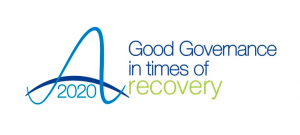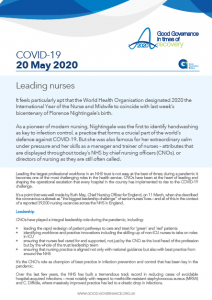Leading nurses
20 May 2020

It feels particularly apt that the World Health Organisation designated 2020 the International Year of the Nurse and Midwife to coincide with last week’s bicentenary of Florence Nightingale’s birth.
As a pioneer of modern nursing, Nightingale was the first to identify handwashing as key to infection control, a practice that forms a crucial part of the world’s defence against COVID-19. But she was also famous for her extraordinary calm under pressure and her skills as a manager and trainer of nurses – attributes that are displayed throughout today’s NHS by chief nursing officers (CNOs), or directors of nursing as they are still often called.
Leading the largest professional workforce in an NHS trust is not easy at the best of times; during a pandemic it becomes one of the most challenging roles in the health service. CNOs have been at the heart of leading and shaping the operational escalation that every hospital in the country has implemented to rise to the COVID-19 challenge.
It’s a point that was well made by Ruth May, Chief Nursing Officer for England, on 11 March, when she described the coronavirus outbreak as "the biggest leadership challenge" of senior nurses’ lives – and all of this in the context of a reported 39,000 nursing vacancies across the NHS in England.
Leadership
CNOs have played a integral leadership role during the pandemic, including:
- leading the rapid redesign of patient pathways to care and treat for ‘green’ and ‘red’ patients
- identifying workforce and practice innovations including the skilling-up of non-ICU nurses to take on roles in ICU
- ensuring that nurses feel cared for and supported, not just by the CNO as the local head of the profession but by the whole of the trust leadership team
- ensuring that nursing practice is aligned not only with national guidance but also with best practice from around the NHS
It’s the CNO’s role as champion of best practice in infection prevention and control that has been key in the pandemic.
Over the last few years, the NHS has built a tremendous track record in reducing cases of avoidable hospital-acquired infections – most notably with respect to methicillin-resistant staphylococcus aureus (MRSA) and C. Difficile, where massively improved practice has led to a drastic drop in infections.
This battle against hospital-acquired infections in the early 2000s was very much nurse-led and the vital role of CNOs continues in the current pandemic, alongside directors of infection prevention and control.
Helping staff feel safe
As COVID-19 admissions started to increase it became apparent that a whole new suite of procedures was required to minimise the risks to patients and staff. During this time, the CNO’s role was as a facilitator between the nursing staff, infection prevention and control practitioners and care providers.
The job was to find the best way to make staff feel safe and provide whatever they needed to safely care for patients, including personal protective equipment (PPE) and information.
The battle against COVID-19 highlights the combination of technical skills and the human touch that nursing provides.
As one CNO said, the job is to understand that your staff is the most important part of managing care in a pandemic. They need constant face time – “senior leader rounding on steroids” – so they know what is happening and can perform at their best.
New phase, new challenges
Now the focus is shifting to restoration and recovery and the CNO is facing a whole new set of challenges best summarised in the following questions:
- What is the plan for restoring services in a way that is fair and equitable and meets the best interests of patients and the wider community?
- How can services be brought back online in ways that minimise the risk of infection to patients and staff?
- What are the new service models to get non-COVID patients treated and what is the nature of the workforce that will be required to restore services safely?
- How do I work with the nurses to build their confidence in these new ways of working?
- What is the support I need from my executive and non-executive colleagues to make all of this work for patients, staff and the trust?
- What support do I need to stay resilient and safeguard my well-being?
The WHO’s choice was a good one – this is indeed a good year to reflect on the extraordinary contribution made by nurses and midwives. It’s also likely to be the year when the boards of NHS organisations appreciate the leadership of their CNOs more than ever before.
As ever, we are keen to hear your views. If this briefing prompts any questions or comments, please call us on 07732 681120 or email advice@good-governance.org.uk.

Darren Grayson
Executive Director
(Partner)

